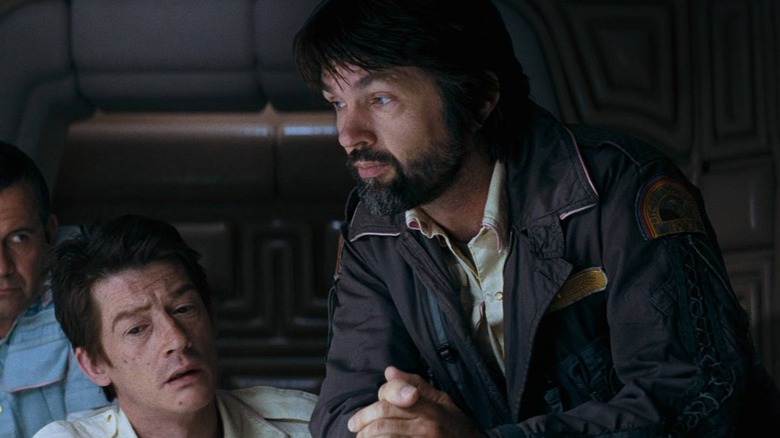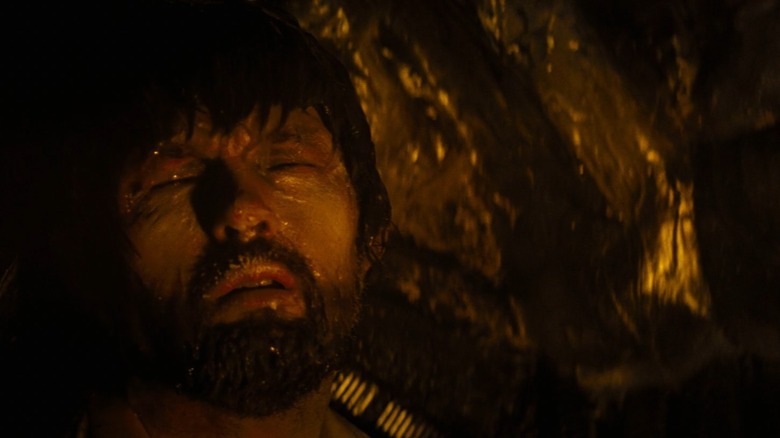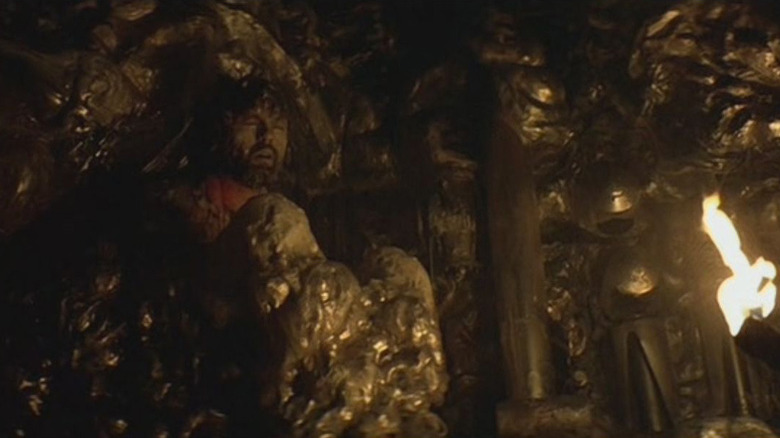
It wasn't until the release of James Cameron's 1986 film "Aliens" that it was established where xenomorph eggs come from. In Ridley Scott's 1979 original "Alien," an extraterrestrial storehouse full of leathery eggs was seemingly left behind unattended. Where the eggs came from, and what they were doing in the storehouse, would remain a mystery. Inside one of the eggs was centipede-like bone critter that rammed its ovipositor down the throat of Kane (John Hurt) and forced him into a coma, clinging onto his face. This "facehugger" was in fact implanting a creature fetus into Kane's chest. Soon, the facehugger drops off of Kane's face, dead, and Kane regains consciousness. The alien young then unexpectedly explodes forcefully out of Kane's stomach.
The life cycle of a xenomorph is now familiar to horror fans the world over, but at one point it wasn't so clear, and the discovery was horrifying. Cameron, when making his sequel, attempted to expand the lifecycle of the xenomorphs by likening them to ants or other insects. In Cameron's version of things, the eggs were laid by an outsize xenomorph "queen," and the climax of his film is devoted to Ellen Ripley (Sigourney Weaver) doing hand-to-hand combat with a 20-foot monster made of teeth.
In the director's cut of "Alien," released in theaters in 2003, a previously deleted scene revealed that a queen was initially not part of xenomorph canon. In Scott's version of things, a single creature could cocoon its prey in leathery sacs and transform their corpses into eggs.
This scene, as revealed by "Alien" actor Tom Skerritt in a 2019 interview with RogerEbert.com's Peter Sobczynski, was not intended to be included in the final cut, but had to be shot anyway for contractual reasons.
Alien Perspiration

Primarily, Skerritt recalls how difficult shooting "Alien" actually was. Scott wanted his on-screen ship, the Nostromo, to look humid and steamy, and many backgrounds are wet with condensation. The glycerin-based artificial perspiration used on "Alien" was infamously troubling for star Sigourney Weaver, who discovered she had an allergy to it. Skerritt remembers sweating, usually in trying to keep up with a constantly in-motion Scott, and being really uncomfortable being pasted to the wall.
"With that particular scene, all I really remember is that it was really uncomfortable -- I was grunting. Ridley was operating the camera and so there was a lot of preparation because I was following him around and watching how he was doing everything."
Despite the struggles, Skerritt had nothing but glowing things to say about his co-workers, feeling that the struggle brought them close and achieve a mutual level of professionalism. It was the rapport he had with cast and director, he feels, that made the movie as strong as it is. Skerritt's character, Dallas, is the captain of a team of none-too-sophisticated blue-collar workers that have often been compared to truckers. The fictional characters shared a weary workplace camaraderie. That same camaraderie was shared by the actors. Skerritt said:
"The respect that I had for the other actors and the respect that they had for me ... We were all working on the same level and trying to survive through this film, which was very hard to make. There were days where you didn't work at all and you were just sitting around. You apply that to something that is then going out of control, such as dealing with a creature that bleeds acid and which doesn't seem to die."
Cocoon, The Return To Set

Scott, meanwhile, was more concerned with pacing and tone than he was with lore. As Skerritt said, a film like "Alien" is all about rhythm, and it was important to keep a sense of speed and panic in place during the picture's final scenes. When Ellen Ripley, Weaver's character, is seemingly alone on the ship with a killer monster, she has to run to various distant control panels to initiate a self-destruct and flee into an escape pod. In the original cut of "Alien," Ripley's climactic dash is interrupted by her discover of Dallas, cocooned against the wall. He is being transformed, covered with sweat. He pleads with Ripley to be put out of his misery.
"[T]here was a scene at the end that they had to take out because it broke the pace ... [Ripley] is pulling out electronics and disengaging them and the ship is going to blow up in a certain amount of time [...] She stops to look for the cat, and then has a conversation with me as I am being eaten up by this cocoon on the wall where I am saying 'Kill me.' [...] It took two days to shoot that scene. But he was paid to do it, to shoot as close as he could to the screenplay. He obliged them and did that, but he then properly cut it out."
Details of Scott's contract are not clear, but it seems that the scene was merely required, even if the film's overall pace would be interrupted. Eventually, the scene was re-inserted into the 2003 theatrical re-release of "Alien," but by then, thanks to sequels, the mythos had changed.
As it stands, the re-inserted scene is a fun aesthetic experiment for editing enthusiasts.
Read this next: 20 Movies About Aliens That You Definitely Need To Watch
The post Alien's Contract Forced Ridley Scott To Film Scenes He Knew Would Never Make The Cut appeared first on /Film.
0 Commentaires